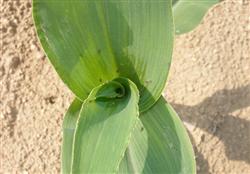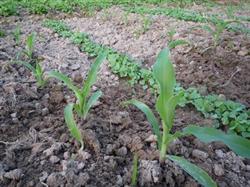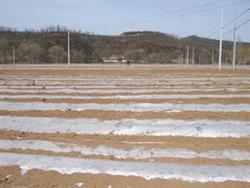Cultivation techniques of transplanting Spring Maize with plastic Film

Transplanting spring corn with plastic film is the method of raising seedlings in nutrient bowl in plastic film arch shed and transplanting with plastic film mulching. Aiming at the two major climatic disasters of frost injury and waterlogging injury in the early stage of maize seedlings, it is a new technical system for the early development of spring maize seedlings, which overcomes the low seedling rate of single cultivation with plastic film and is not easy to strengthen seedlings. So that corn sowing is basically not affected by weather conditions, and strive for early seedlings, whole seedlings and strong seedlings. Further improve the ecological conditions of spring maize, promote the growth and development of maize along the normal track, so as to obtain high yield. Xiangshui County adopted transplanting plastic film to cultivate spring corn of 30,000 mu, with an average yield of 642 kg, which was 9.8% higher than that of single plastic film mulching cultivation. This method is also an effective way to realize corn-based multi-cropping system. 1. Good hybrids were selected for transplanting plastic film mulching cultivation according to the sum of local accumulated temperature and film mulching temperature up to 2650 ℃ ~ 2800 ℃. Late maturing maize hybrids can be selected. The practice of high yield has proved that Yedan 13 and Yedan 12 are ideal varieties to achieve super high yield in this area. In order to carry out maize double-season cultivation or single plastic film mulching cultivation, medium-ripening maize hybrids Yedan 22, Xiyu 3 and Suyu 9 should be selected. These middle and late mature varieties have compact plant type, good light transmittance, stout stalk, strong lodging resistance, large spike and many grains, high productivity per plant and great potential for yield increase; the growth period is moderate, they are cultivated by transplanting plastic film, and generally mature around the middle of July, which has little effect on the following corn. 2. Timely double-film seedling raising on the basis of the original single-film scaffolding, cover the bed with a layer of plastic film. The temperature of double film seedling increased significantly, which was 2 ℃ ~ 3 ℃ higher than that of single film. It can accelerate the speed of soil water circulation in the seedbed, promote the seeds to absorb water evenly, and achieve neat and healthy seedling emergence. Cultivate early and strong seedlings, transplant at the right time, and give full play to the advantages of early seedling and early emergence. ① fattening nursery bed: implement fertilizing bed to raise seedlings, select rape seedbed, dry nursery pond as spring corn nursery bed. If the seedling bed is kept in proportion, the ratio of the seedling bed to the field area is 1: 20 when the bowl diameter is 5 cm, and the ratio of the seedling bed to the field area is 1: 10: 15 when the bowl diameter is more than 7 cm. It is necessary to plough the bed soil in time in early spring, let it be fully exposed to the sun, and promote its bed soil to activate bubble pine. Before making the bowl, remove the weeds in the seedbed and improve the quality and efficiency of making the bowl. Spring corn seedbed should be rich in nutrition, which requires: first, to improve the soil of the bed, second, to supply multiple nutritional ingredients in time, and third, to prepare nutritious soil scientifically. According to the production practice, the standard bed is 1.5 meters wide and 4.5 meters long before the Spring Festival. Nutritive soil was made from 300 kg ~ 400 kg of human and animal manure, 3 kg of phosphate fertilizer, 1.5 kg ~ 2 kg of ammonium bicarbonate and 0.5 kg of potash fertilizer. Then add Huimanfeng 150ml and mix it evenly to increase the nutrition of seedling bed, enhance the stress resistance of seedlings and improve the quality of maize seedlings. The number of ② pots: bed soil, fertilizer and Huimanfeng were fully mixed evenly. After adding suitable water, there were 4800 ~ 5000 pots per mu. Ensure enough effective number of plants to transplant. ③ sowing at the right time: the suitable time for seedling sowing is March 15 ~ 20, seedling stage 15 ~ 20 days, leaf age 2.5 ~ 3.5 leaves, transplanting to field plastic film in early April. ④ to cultivate strong seedlings: to carefully raise seedlings, cultivate strong seedlings. The seedbed is watered with moisture at the bottom, sow 1 ~ 2 large seeds on each bowl, and cover the moist fine soil 1.5 cm ~ 2 cm in time. Flat plastic film, and then arch shed plastic film, the surrounding cover is strict, heat preservation and moisturizing to promote growth. Remove the mulch after finishing the seedling. Replenish water flexibly and water the bed in time when the bed is white. Ventilation and cooling in time for high temperature at noon. One leaf and one heart stage gradually uncover the arch greenhouse film to refine the seedlings, generally about 3 days. One day before planting, the seedlings were sprayed with activin and water to enhance the resistance of maize and cultivate early and strong seedlings with strong resistance. 3. Transplanting in time the temperature in this area is stable through 12 ℃, about April 5, when the maize seedlings have two leaves and one heart, they can be transplanted out of bed. Transplanting should be timely, the survival rate is high, prevent transplanting too late, affect the quality of maize seedlings and seedlings after planting, in order to ensure that plastic film corn can make full use of local heat resources. 4. Before transplanting corn seedlings with sufficient base fertilizer, field base fertilizer should be applied 10 days before transplanting. Plastic film corn consumes a lot of soil fertility, so it is necessary to increase the application of organic fertilizer and balance the use of chemical fertilizer. According to the local soil characteristics, corn usually needs to apply 2000 kg ~ 44000 kg of rotten barnyard manure, 20 kg ~ 25 kg of pure nitrogen, 10 kg ~ 15 kg of phosphorus pentoxide, 15 kg of potassium oxide and 1 kg ~ 1.5kg of zinc sulfate. Plastic film mulching corn is difficult to top fertilizer, which grows fast in the early stage and needs a large amount of fertilizer, so the application proportion of base fertilizer should be increased. 50% of nitrogen fertilizer, phosphorus, potassium and zinc fertilizer are all used as base fertilizer. When finishing the bed surface, apply it evenly under the plastic film. Before mulching, 150 grams of 40% atrazine glue suspension, 72% Dur EC 100 ml ~ 150 ml, and 50 kg water were sprayed evenly on the surface before mulching, which could effectively inhibit weeds in the field during the whole corn growing period. 5. at present, most of the maize hybrids used in production are one ear per plant, and one less plant is less than one ear, which directly affects the increase of yield. In general, there are about 4500 plants in high-yield fields and 5000 ~ 5500 plants in ultra-high-yield fields. Adopt large and small row planting, large row 80 cm, small row 40 cm, plant spacing according to high-yield design. Use the bowl maker to open a hole in the plastic film, and then transplant the nutrition bowl seedlings into the hole. It is necessary to transplant with fertilizer and water, so that the nutrition bowl seedlings are closely connected with the soil, and cover the mouth of plastic film, so that they can live and grow rapidly after planting. 6. Jointing fertilizer was applied skillfully when topdressing fertilizer was applied in time. When 6 leaves of corn were unfolded, jointing fertilizer was applied, and nitrogen fertilizer accounted for 15% of the total nitrogen fertilizer. The heavy application of panicle fertilizer was carried out in the 10 ~ 11 leaves of maize, and topdressing fertilizer per mu accounted for 35% of the total nitrogen fertilizer in the Dabakou stage, which promoted the differentiation of female spikelet floret and grain formation, and irrigated enough water to meet the fertilizer and water needs of maize growth, so that the ear grain weight increased synchronously. 7. due to the change of soil environmental conditions, the activity of underground pests is early and the harm is relatively serious, so it should be controlled in time. Take medicine to the field when transplanting, use 3% carbofuran granule with fine soil 15 kg per mu, apply under plastic film before planting. Or use 50% methamidophos EC 500 times to prepare poison bait and sprinkle it on the ground before coating. During the period of big trumpet mouth of corn, 4 kg ~ 5 kg of carbofuran granules and 5 kg ~ 10 kg of fine sand were made into arsenopyrite and sprinkled on the heart leaves. Or infuse heart leaves with 1500-2000 times of 90% trichlorfon, and 100 corn plants can be irrigated per kilogram. Control corn borer. Before and after the male selection of corn, 50% Jingangmycin 100 ~ 150 grams per mu and 50 kg of water were sprayed on stems and leaves to control sheath blight and size spot. 8. After opening the ditch line corn planting, dig the ditch in the field in time, so that the field ditch system is smooth, can be irrigated and can be drained, and there is no stagnant water in the field with daily rainfall of 200 mm. The standard of ditch system should be high, increase field ditch density, reduce groundwater, eliminate surface water and prevent waterlogging damage. In case of drought, timely irrigation can prevent drought and promote the healthy growth of corn.
- Prev

Key points of Seedling raising and transplanting of Spring Maize
At present, we are about to enter the sowing season of spring corn, so we should do a good job of seedling raising and transplanting in production to promote the early development and stable growth of maize and achieve high and stable yield. For the fields with good varieties to harvest tender corn cobs, the fields with good quality such as Jiangnan Huanuo and Suyunuo should be selected, and Zheng Yu with high yield should be selected for harvesting corn kernels.
- Next

Cultivation techniques of Spring Maize intercropping and Autumn Cucumber
Soil preparation and fertilization should be planted in plots with sunny, ventilated, deep soil layer, loose, fertile, adequate water source and good drainage. The base fertilizer should be mainly organic fertilizer, combined with autumn ploughing, the earlier the better, so that the fertilizer can be fully decomposed and integrated with the soil. According to the experiment, the yield of applying base fertilizer in autumn is 14.9% higher than that in spring.
Related
- The first cup of black tea in spring, the flavor and history of tea gardens in Kenya, Africa
- The computer can not only choose potatoes, but also grow tea rice. AI will grow winter oolong tea champion.
- It is not only the inflated tea bitten by insects, but also engraved with the four seasons tea in Beipu.
- The Oriental Beauty Tea Festival in Zhuxian County takes the stage at the weekend to experience the plus-size feast of oil tea.
- & quot; Oriental Beauty Tea & Exploration of Emei in Hsinchu, the hometown of quot;
- The new variety of strawberry "Tainong 1" dessert is the first choice with mellow aroma. Crimson gorgeous
- History of Tea in Taiwan: from Wild Inner Mountain to Export Tea Garden
- Two types of Taiwan Oriental Beauty Black Tea won the British three-Star Award for Childhood Tea Xiang Zhang Jiaqi changed from pilot to champion tea maker.
- Banana species and varieties: the planting history of Taiwan Xianren banana and dwarf banana is long, is banana disease resistant?
- Coffee planting Technology: Qianjie Coffee from Seedling to harvesting

